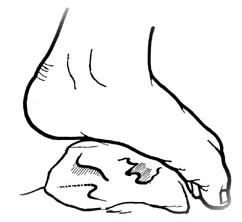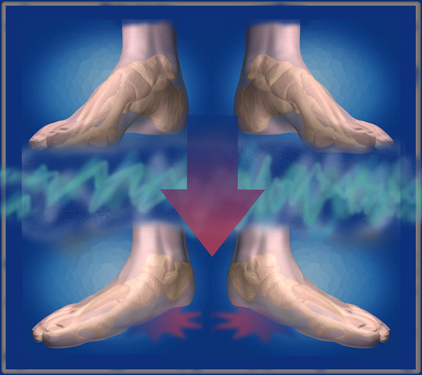|
Pronation:
The Biomechanical Anachronism
By Edward Glaser, DPM
Human anatomy is a work in progress, as are the anatomies of all species. The fact that the changes are imperceptibly slow and require millennia of time to develop does not alter the reality that all species are engaged in an ongoing adaptation to changes in the natural world. At one time, our world was all about splitting our time between trees and ground. Then it was always the ground. In both cases, having feet that adapt easily to the rounded strata of tree limbs, rocks on the ground or the odd slopes of hills was a big advantage for traction and balance. And this was true for the vast majority of our species' existence.

Enter the orthogonal squareness of the Industrial Revolution. Cities are carved into blocks, surfaces everywhere are being paved. The factory floors are made flat and hard for efficiency and supporting heavy machinery. People shifted, in a matter of a few generations, from the walking the soft, variegated farm fields to working all day on hard, flat flooring. Then concrete was invented in 1824 and we have never looked back. Shoes help protect and stiffen the foot against these hard, flat surfaces, but no shoe can protect the arch of the foot from the relentless hammering of gravity and body weight against the anvil of paved flooring. A perfect environment for progressive stretching of foot ligaments was created.

Of course, we have no research of the before and after effects on the foot from that time of transition. However, it seems quite reasonable to conclude that our ability to pronate turned decisively towards more liability than asset. In fact, were we rapid adaptors, perhaps we need something closer to wheels than feet in this modern environment (Actually, part of normal foot function, the “rocker” mechanisms often cited during gait analysis, come close to wheel function, but I’ll leave that for the next article). The wonderful, modern shoe materials give us most of the shock absorption we need as well. So what is left for pronation to contribute?
That is a very good and interesting question –one which those of us involved in developing MASS Position Theory have been struggling with for some time. Because the MASS approach, which limits pronation more aggressively than any other, has not seen a problem with the relatively gross restriction of pronation. In fact, most everyone reports a huge improvement in both function and reversal of pain or deformity. So the question seems to us to be: how much pronation is functionally necessary? We are funding the research currently to try to answer this and many other questions. But our provisional hypothesis going forward remains: not much.
Foot orthotics have been reported to enhance balance or stability, but the mechanisms are largely anecdotal1. Is it because control of pronation is related to improved proprioception? Investigations have shown that postural stability is related to foot type, but more likely a result of structural stability rather than altered proprioception2. A recent study by Cobb et al3 found a significant improvement in “postural stability” or balance after 6 weeks of using a MASS-type orthosis. Toes also contribute significantly to balance4 (as opposed to the anecdotal remark that they are “organs designed to find furniture in the dark”). So perhaps we need only a relatively small tarsal shift during pronation to give us enough proprioceptive feedback to supplement what we are receiving from the plantar surface of the foot and the toes.
These musings are not trivial. For what we do know are the many deleterious consequences to the foot of over-pronation, the details of which have been outlined in previous articles here. The sources of over-pronation are numerous, though the fundamental one we believe is the new ground we walk on. There is also the problem of growing obesity in the general population, giving us ever bigger hammers against the concrete. Sedentary living reduces the muscular component of pronation control. Tight calves and hamstrings are very common. When the calves are tight they encourage adaptive flattening of the arch to allow more ankle dorsiflexion. Many common, everyday factors are converging on our feet to reduce them to dysfunctional pancakes. That is why we are testing the waters, re-evaluating the role and importance of pronation in today’s world.
****
Reference List
(1) Rome K, Brown CL. Randomized clinical trial into the impact of rigid foot orthoses on balance parameters in excessively pronated feet. Clin Rehabil 2004 September;18(6):624-30.
(2) Cote KP, Brunet ME, Gansneder BM, Shultz SJ. Effects of Pronated and Supinated Foot Postures on Static and Dynamic Postural Stability. J Athl Train 2005 March;40(1):41-6.
(3) Cobb SC, Tis LL, Johnson JT. The effect of 6 weeks of custom-molded foot orthosis intervention on postural stability in participants with >or=7 degrees of forefoot varus. Clin J Sport Med 2006 July;16(4):316-22.
(4) Tanaka T, Hashimoto N, Nakata M, Ito T, Ino S, Ifukube T. Analysis of toe pressures under the foot while dynamic standing on one foot in healthy subjects. J Orthop Sports Phys Ther 1996 March;23(3):188-93.
|